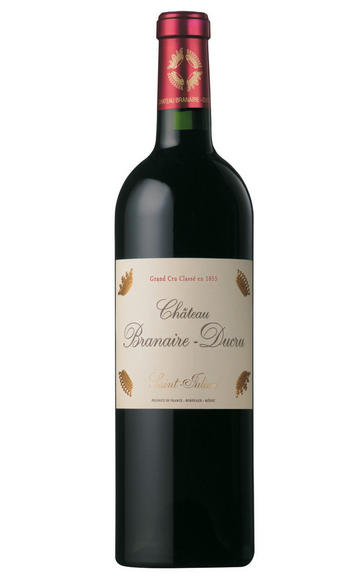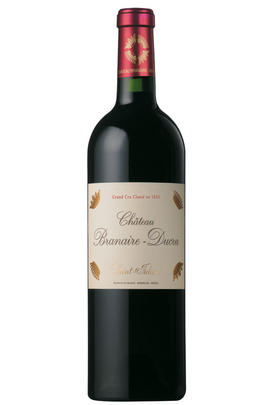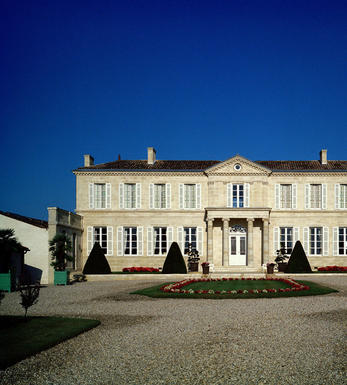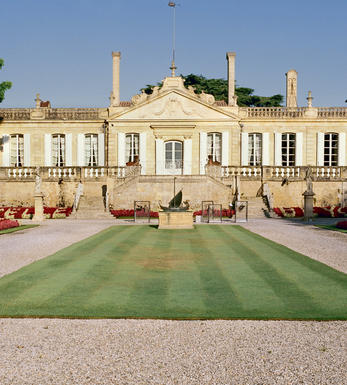
2018 Château Branaire-Ducru, St Julien, Bordeaux

Critics reviews
The 2018 Branaire-Ducru was picked from September 19 until October 10 at 53hl/ha and is currently being aged in 60% new oak. It has retained the sophisticated bouquet that I found last year, featuring beautifully defined blackberry and cedar and hints of iris flower and rose petals. The palate is well-defined with good density and backbone, something that you could argue was missing from Branaire-Ducru in the 1990s and early 2000s. It gently fans out on the finish but never wants to create too much of a commotion – that’s not its style. This indicates a property that is finding a new lease on life. Excellent.
Drink 2023 - 2045
Neal Martin, Vinous.com (March 2021)
The 2018 Branaire-Ducru is every bit as captivating as it was en primeur. Ripe, silky tannins give the 2018 a striking air of sensuality that only grows as the wine sits in the glass. Succulent red/purplish fruit, lavender, rose petal, mint, spice and gravel inflections all open more over time. Even with all of its natural radiance, Branaire remains a model of grace. It is unquestionably one of the under-the-radar wines of the year.
Drink 2026 - 2048
Antonio Galloni, Vinous.com (March 2021)
53hl/ha yield
Branaire-Ducru has managed to produce an exceptionally balanced and refined St-Julien in a year when that was not the easiest task. Depth and complexity are clear, although it's just a little held back right now. The architecture is such that there are walls to scale and depths to plumb but with less generosity overall.
Drink 2027 - 2040
Jane Anson, Decanter.com (April 2019)
The 2018 Branaire-Ducru has a medium to deep garnet-purple color and an upfront, expressive nose of baked black plums, boysenberries and Morello cherries with an undercurrent of dried mint, spice box and underbrush. Medium to full-bodied, the palate packs a very pleasant fruit wallop, featuring juicy black fruits and a firm, grainy frame, finishing long with lovely purity.
Drink 2023 - 2043
Lisa Perrotti-Brown MW, Wine Advocate (March 2021)
Tasted blind. Not that deep a crimson. Light and fresh – lunchtime claret?! Easy-peasy. Until some pretty grainy tannins on the end.
Drink 2026 - 2040
Jancis Robinson MW, JancisRobinson.com (February 2022)
Very attractive aromas of currants, tile and sandalwood with black and red currants. It’s full-bodied with a tight, dense centre palate that remains closed in and tight. Yet there is underlying seriousness and length to this. Perhaps the greatest Branaire-Ducru ever made.
Try after 2026
James Suckling, JamesSuckling.com (February 2022)
Really ripe, heady perfumed fruit on the nose, no longer just floral aromas but proper perfume, so expressive - wild and evocative, the first one to be so seductively evocative on the nose. Smooth and sleek with silky tannins, a hefty dose of spice and ripe blackcurrant, black cherry and blueberry but extremely refined so you get all the flavours but with softness and grace. This feels concentrated and powerful no doubt but it's calm also, restrained and just holding back. Bold, but beautiful. I like this a lot.
Drink 2028 - 2050
Georgina Hindle, Decanter.com
About this WINE

Château Branaire-Ducru
Classified as a fourth growth in 1855, Ch. Branaire-Ducru makes pure and classic St Julien. The estate has recently passed from father to son: the widely respected Patrick Maroteaux – who had served at various times as president of the Union des Grands Crus de Bordeaux and the St Julien appellation – sadly passed away in 2017. His son François-Xavier has picked up the baton and continues his father’s legacy. The Maroteaux family bought the property in 1988 and have invested considerably in the vineyard and winery since. Superstar consultant Eric Boissenot advises here, as he does with many of the Left Bank’s top estates, including the Médoc’s four first growths.

St Julien
St Julien is the smallest of the "Big Four" Médoc communes. Although, without any First Growths, St Julien is recognised to be the most consistent of the main communes, with several châteaux turning out impressive wines year after year.
St Julien itself is much more of a village than Pauillac and almost all of the notable properties lie to its south. Its most northerly château is Ch. Léoville Las Cases (whose vineyards actually adjoin those of Latour in Pauillac) but, further south, suitable vineyard land gives way to arable farming and livestock until the Margaux appellation is reached.
The soil is gravelly and finer than that of Pauillac, and without the iron content which gives Pauillac its stature. The homogeneous soils in the vineyards (which extend over a relatively small area of just over 700 hectares) give the commune a unified character.
The wines can be assessed as much by texture as flavour, and there is a sleek, wholesome character to the best. Elegance, harmony and perfect balance and weight, with hints of cassis and cedar, are what epitomise classic St Julien wines. At their very best they combine Margaux’s elegance and refinement with Pauillac’s power and substance.
Ch. Léoville Las Cases produces arguably the most sought-after St Julien, and in any reassessment of the 1855 Classification it would almost certainly warrant being elevated to First Growth status.
Recommended Châteaux: Ch. Léoville Las Cases, Ch.Léoville Barton, Ch Léoville Poyferré, Ch. Ducru-Beaucaillou, Ch Langoa Barton, Ch Gruaud Larose, Ch. Branaire-Ducru, Ch. Beychevelle

Cabernet Sauvignon Blend
Cabernet Sauvignon lends itself particularly well in blends with Merlot. This is actually the archetypal Bordeaux blend, though in different proportions in the sub-regions and sometimes topped up with Cabernet Franc, Malbec, and Petit Verdot.
In the Médoc and Graves the percentage of Cabernet Sauvignon in the blend can range from 95% (Mouton-Rothschild) to as low as 40%. It is particularly suited to the dry, warm, free- draining, gravel-rich soils and is responsible for the redolent cassis characteristics as well as the depth of colour, tannic structure and pronounced acidity of Médoc wines. However 100% Cabernet Sauvignon wines can be slightly hollow-tasting in the middle palate and Merlot with its generous, fleshy fruit flavours acts as a perfect foil by filling in this cavity.
In St-Emilion and Pomerol, the blends are Merlot dominated as Cabernet Sauvignon can struggle to ripen there - when it is included, it adds structure and body to the wine. Sassicaia is the most famous Bordeaux blend in Italy and has spawned many imitations, whereby the blend is now firmly established in the New World and particularly in California and Australia.


Buying options
Add to wishlist
Description
58% Cabernet Sauvignon, 33% Merlot, 5% Cabernet Franc, 4% Petit Verdot.
This year, the wine sees a little more Merlot in the blend than usual as the old plots performed superbly – as did the Petit Verdot. The mildew was well-controlled, and the yield is 53 hl/ha. It is quite a voluptuous style for Branaire, which comes from the last-harvested plots on clay. The core of the wine remains typically Branaire: perfumed, discrete and sculpted.
Drink 2025 - 2038
Berry Bros. & Rudd
wine at a glance
Delivery and quality guarantee